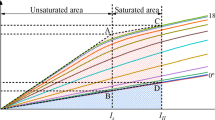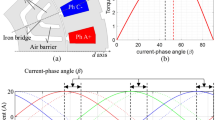Abstract
This study presents a shape optimization framework that can determine the optimal rotor and stator shapes of the switched reluctance motors (SRM). The goal of design optimization is to adjust a torque profile to the target torque under the current limitation. For this purpose, the spline-based pole-shape representation and stator-fitted coil representation are implemented to precisely represent the complicated geometry of the SRM. Through linking the electromagnetic field analysis module (ANSYS Maxwell) and the electric circuit analysis module (ANSYS Simplorer), the performance of the SRM is evaluated with consideration of a high nonlinearity due to the magnetic saturation. Then, the shape optimization is extensively performed to quantitatively investigate a relation between the optimal shapes and target performance (i.e., average torque, torque ripple, and current limitation in this study). These numerical results provide an informative design guideline for determining the optimal rotor and stator shapes of the SRM to achieve a high average torque and a low torque ripple under the given current limitation.


















Similar content being viewed by others
References
Arumugam R, Lowther D, Krishnan R, Lindsay J (1985) Magnetic field analysis of a switched reluctance motor using a two dimensional finite element model. IEEE Trans Magn 21(5):1883–1885
Balaji M, Kamaraj V (2012) Evolutionary computation based multi-objective pole shape optimization of switched reluctance machine. Electr Power Energy Syst 43(1):63–69
Benhama A, Willamson AC, Reece ABJ (1999) Force and torque computation from 2-D and 3-D finite element field solutions. IET Proc-Electr Power Appl 146(1):25–31
Choi YK, Yoon HS, Koh CS (2007) Pole-shape optimization of a switched-reluctance motor for torque ripple reduction. IEEE Trans Magn 43(4):1797–1800
Gan C, Wu J, Sun Q, Kong W, Li H, Hu Y (2018) A review on machine topologies and control techniques for low-noise switched reluctance motors in electric vehicle applications. IEEE Access 6:31430–31443
Kano Y, Kosaka T, Matsui N (2010) Optimum design approach for a two-phase switched reluctance compressor drive. IEEE Trans Ind Appl 46(3):955–964
Kim YS, Park IH (2010) Topology optimization of rotor in synchronous reluctance motor using level set method and shape design sensitivity. IEEE Trans Appl Supercond 20(3):1093–1096
Lee J (2010) Structural design optimization of electric motors to improve torque performance. University of Michigan, Ann Arbor
Lee J, Seo JH, Kikuchi N (2010) Topology optimization of switched reluctance motors for the desired torque profile. Struct Multidiscip Optim 42(5):783–796
Lee D, Pham TH, Ahn J (2013) Design and operation characteristics of four-two pole high-speed SRM for torque ripple reduction. IEEE Trans Ind Electron 60(9):3637–3643
Li G, Ojeda J, Hlioui S, Hoang E, Lecrivain M, Gabsi M (2012) Modification in rotor pole geometry of mutually coupled switched reluctance machine for torque ripple mitigating. IEEE Trans Magn 48(6):2025–2034
Liang J, Parsapour A, Moallem M, Fahimi B, Kiani M (2019) Torque profile optimization in switched reluctance motor, 2019 IEEE 28th International Symposium on Industrial Electronics (ISIE)
Liu X, Wang Z, Wan D, Huang S (2019) Structure optimization of switched reluctance motor for torque ripple suppression, 2019 22nd International Conference on Electrical Machines and Systems (ICEMS)
Ma C, Qu L (2015) Multiobjective optimization of switched reluctance motors based on design of experiments and particle swarm optimization. IEEE Trans Energy Convers 30(3):1144–1153
Mirzaeian B, Moallem M, Tahani V, Lucas C (2002) Multiobjective optimization method based on a genetic algorithm for switched reluctance motor design. IEEE Trans Magn 38(3):1524–1527
Raminosoa T, Blunier B, Fodorean D, Miraoui A (2010) Design and optimization of a switched reluctance motor driving a compressor for a PEM fuel-cell system for automotive applications. IEEE Trans Ind Electron 57(9):2988–2997
Schoenberg IJ (1988) Contribution to the problem of approximation of equidistant data by analytic functions, IJ Schoenberg Selected Papers: 3-57
Schoenberg IJ (1946) Contributions to the problem of approximation of equidistant data by analytic functions – Part B – On the Problem of Osculatory Interpolation. A Second Class of Analytic Approximation Formulae, Quarterly of Applied Mathematics 4(2): 112–141
Sheth NK, Rajagopal KR (2004) Torque profiles of a switched reluctance motor having special pole face shapes and asymmetric stator poles. IEEE Trans Magn 40(4):2035–2037
Uler GF, Mohammed OA, Koh CS (1994) Utilizing genetic algorithms for the optimal design of electromagnetic devices. IEEE Trans Magn 30(6):4296–4298
Xue XD, Cheng KWE, Ng TW, Cheung NC (2010) Multi-objective optimization design of in-wheel switched reluctance motors in electric vehicles. IEEE Trans Ind Electron 57(9):2980–2987
Zhang H, Xu W, Wang S, Huangfu Y, Wang G, Zhu J (2014) Optimum design of rotor for high-speed switched reluctance motor using level set method. IEEE Trans Magn 50(2):765–768
Funding
This research was supported by a grant (20TLRP-C135446-04, Development of Hybrid Electric Vehicle Conversion Kit for Diesel Delivery Trucks and its Commercialization for Parcel Services) from Transportation and Logistics Research Program (TLRP) funded by Ministry of Land, Infrastructure, and Transport of Korean government.
Author information
Authors and Affiliations
Corresponding author
Ethics declarations
Conflict of interest
The authors declare that they have no conflict of interest.
Replication of Results
All the presented results can be replicated, and all the necessary data sets and a flowchart for the problems are presented in the manuscript. The software used in this study is protected by Ministry of Land, Infrastructure and Transport of Korean government. Due to this confidential issue, we cannot share the software publicly.
Additional information
Responsible Editor: Ming Zhou
Publisher’s note
Springer Nature remains neutral with regard to jurisdictional claims in published maps and institutional affiliations.
Rights and permissions
About this article
Cite this article
Lee, C., Lee, J. & Jang, I.G. Shape optimization-based design investigation of the switched reluctance motors regarding the target torque and current limitation. Struct Multidisc Optim 64, 859–870 (2021). https://doi.org/10.1007/s00158-021-02897-0
Received:
Revised:
Accepted:
Published:
Issue Date:
DOI: https://doi.org/10.1007/s00158-021-02897-0




